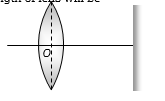A concave mirror of focal length 100 cm is used to obtain the image of the sun which subtends an angle of . The diameter of the image of the sun will be
(1)
(2)
(3)
(4) 100 cm
A square of side 3 cm is placed at a distance of 25 cm from a concave mirror of focal length 10 cm. The centre of the square is at the axis of the mirror and the plane is normal to the axis. The area enclosed by the image of the square is
(1)
(2)
(3)
(4)
One face of a rectangular glass plate 6 cm thick is silvered. An object held 8 cm in front of the first face, forms an image 10 cm behind the silvered face. The refractive index of the glass is [Consider that light ray returns back in the first medium]
(a) 0.4 (b) 0.8
(c) 1.5 (d) 1.6
One side of a glass slab is silvered as shown. A ray of light is incident on the other side at angle of incidence of . The Refractive index of glass is given as 1.5. The deviation of the ray of light from its initial path when it comes out of the slab is:
(a) 90o
(b) 180o
(c) 120o
(d) 45o
Two transparent slabs have the same thickness as shown. One is made of material A of refractive index 1.5. The other is made of two materials B and C with thickness in the ratio 1:2. The refractive index of C is 1.6. If a monochromatic parallel beam passing through the slabs has the same number of waves inside both, the refractive index of B is
(a) 1.1 (b) 1.2
(c) 1.3 (d) 1.4
Two point light sources are 24 cm apart. Where should a convex lens of focal length 9 cm be put in between them from one source so that the images of both the sources are formed at the same place?
(a) 6 cm (b) 9 cm
(c) 12 cm (d) 15 cm
A rectangular glass slab ABCD, of refractive index , is immersed in water of the refractive index . A ray of light is incident at the surface AB of the slab as shown. The maximum value of the angle of incidence , such that the ray comes out only from the other surface CD is given by
(a) (b)
(c) (d)
A rod of glass ( = 1.5) and of square cross section is bent into the shape shown in the figure. A parallel beam of light falls on the plane flat surface A as shown in the figure. If d is the width of a side and R is the radius of circular arc then for what maximum value of light entering the glass slab through surface A emerges from the glass through B
(1) 1.5
(2) 0.5
(3) 1.3
(4) None of these
A concave mirror is placed at the bottom of an empty tank with face upwards and axis vertical. When sunlight falls normally on the mirror, it is focused at distance of 32 cm from the mirror. If the tank is filled with water upto a height of 20 cm, then the sunlight will now get focussed at
(1) 16 cm above water level
(2) 9 cm above water level
(3) 24 cm below water level
(4) 9 cm below water level
The distance between a convex lens and a plane mirror is 10 cm. The parallel rays incident on the convex lens after reflection from the mirror form image at the optical centre of the lens. Focal length of the lens will be
(1) 10 cm
(2) 20 cm
(3) 30 cm
(4) Cannot be determined











